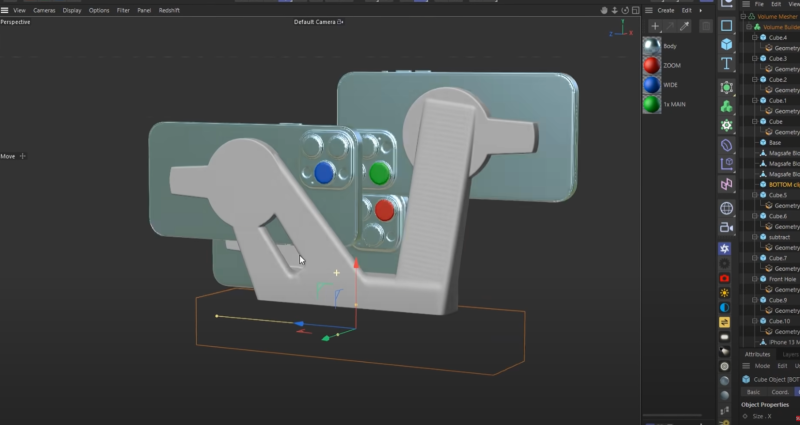People rolling off shields and spears clashing against swords as the camera zooms in and out wildly makes the hallmark action sequences in the movie 300 so iconic. Unfortunately, achieving this effect wasn’t particularly easy. Three cameras were rolling, each with a different lens (100mm, 50mm, and 21mm) to capture a different view of the same scene. In post-production, you can dramatically switch between the three cameras since the shot is synchronized. The folks over at [Corridor Crew] wanted to recreate the effect, but rather than create a custom mount to hold three expensive cameras, they 3d printed a custom mount to hold three costly smartphones.
While there are three cameras on the back of most phones, most phones can’t shoot in slo-mo from all cameras simultaneously. So they would need a rig to hold three phones. The first design was simple and just brackets to hold phones. While nice and sturdy, getting the phones in or out wasn’t easy, and getting to the record button was tricky. iPhones have this handy little magnetic ring on the back. They had a bracket that worked pretty well after a few iterations on the design and some printer issues. Since each camera has optical image stabilization, it is easy for the lenses to get out of alignment, which can mar the shot. However, they somewhat covered up the effect in post. With a working prototype, the only thing left to do was to slice a bunch of piñatas in slow motion with a thrumming soundtrack.
We love seeing exciting camera setups and iterating to find something that works. This dual-camera setup has a very different goal and tries to lean into the parallax effect rather than hide it. Video after the break.
















Do not miss the Cameras and Accessories Contest on Printables.com whit this model/idea :)
The folks at corridor are super good hackers. Glad to see them featured here.
Indeed, a very narrow niche really in what they do, which generally doesn’t appeal to me much, but the how they do it and how they present the steps they took is always good, in the videos interesting enough to me that I’d watch them anyway.
Really neat idea, and simple enough hack to get the 3 cameras doing what they want well enough – if I had wanted to do that I’d have probably spent many times longer learning how to drive what amount to phone camera through a FPGA straight into RAM, and not being an expert at PCB design, while needing a reasonably potent FPGA and not buying any of the parts in huge number it might well work out more costly than this even with the Apple tax..
Or just use duck tape
We can’t reach the camera icon, so instead of changing the interface and moving the camera’s icon to the left of the screen (can’t you do that on iOS ?), let’s spend 3 days and multiple iterations of the CAD design so it doesn’t align anymore correctly but looks cool as a duck when printed.
Iphone users I guess.
Or getting a handful of bluetooth shutter buttons at $1 each.
That was my first thought too. *shrug*
this is neat and well documented but… Is this a “thing” now? This is “content” creation, right? This almost seems like a mythbusters style production, with dedicated production facilities, nearly broadcast quality filming and editing for the video and lots of man-hours of labor for this project. Maybe people are independently wealthy and can do things like this but, who? I’m guessing these style of videos are all paid for with youtube ad revenue. Not passing judgement one way or the other, it was a neat and well made video but a lot of effort ultimately for “I 3-d printed a thing”
Pretty sure they are primarily a video production studio. They made this device to further their production studio productions. In doing so, since they are a production studio, they filmed it while they made it.
I don’t get the reason for this to exist (except for the clicks, of course).
You’re glom three cameras together, with different focal lengths, record a scene simultaneously on all three, and then combine the three videos together later to simulate fast zooming.
In a cinematic set, with real film cameras, I can see (maybe) the point: you want to eke all the resolution out of the film and lenses you can, so it’s worth the pain to re-register and sync and composite the three.
But in this age of 48 megapixel detectors, you can do this with digital zoom trivially, albeit with a modest (and probably unnoticeable) hit in resolution and noise. Trying to combine three independent cameras, each with their own perspective, lens profiles, distortions, sync rates, white balance, exposure, etc, is a huge pain.
So other than to say “I did it”, is there a genuine reason to go through this pain to recreate this kind of shot?
Most of these cameras can’t film at their full resolution in slo-mo, which might make digital zoom a no-go. This could be recreated by some less professional people as long as they have access to a 3d printer, a skateboard and a few people to borrow phones from. Then again, having one really fancy phone film at the highest resolution possible and use software to do both the slo-mo and the zooming might yield better results.
Maybe DAIN
Depth Aware Video Frame Interpolation
https://sites.google.com/view/wenbobao/dain
Other than for the clicks, they did it to troll you into replying.